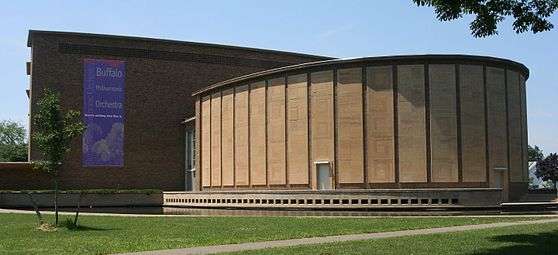Kleinhans Music Hall
Kleinhans Music Hall is a concert venue located on Symphony Circle in Buffalo, New York. The hall "is renowned for its acoustical excellence and graceful architecture."[4] Kleinhans is currently the home of the Buffalo Philharmonic Orchestra, a regular venue for the Buffalo Chamber Music Society, and is rented out for other performing groups and local events. The building was designed by father-and-son team Eliel Saarinen and Eero Saarinen, with help from local architects F. J. and W. A. Kidd, Stanley McCandless as lighting consultant, and Charles C. Potwin as acoustical adviser. Kleinhans has two performance spaces, as well as additional rooms for rehearsals or private events. It was declared a National Historic Landmark in 1989 for its architecture,[3][5] 49 years after its completion.
Kleinhans Music Hall | |
 Kleinhans Music Hall | |
  | |
| Location | Symphony Circle, Buffalo, New York |
|---|---|
| Coordinates | 42°54′07″N 78°53′01″W |
| Area | 4.2 acres (1.7 ha) |
| Built | 1938-40[1] |
| Architect | Eero Saarinen Eliel Saarinen[1][2] |
| Architectural style | International Style[2] |
| NRHP reference No. | 89001235 |
| Significant dates | |
| Added to NRHP | June 29, 1989[2] |
| Designated NHL | June 30, 1989[3] |
Performance Spaces
Kleinhans Music Hall offers two spaces for performances: the main auditorium, and the Mary Seaton Room. The main auditorium of Kleinhans Music Hall offers seats 2,441 (it originally accommodated 2839 seats, but underwent renovations in 2015[6][7]), and showcases the hall's parabolic ceiling and acoustically-informed design. The shape of the hall is such that audience members in the back rows of the balcony will have as clear and instantaneous of an auditory experience as the people in the front rows of the ground level. Charles C. Potwin employed a 1:1.3 ratio in the design of the auditorium to achieve the most ideal acoustic.[5] While the design of the main auditorium is less conducive to reverberation, it aims to create a more intimate experience by drawing the audience in. The austere color palette and simple lines seen in the layout also serve to direct the audience to the music without distraction of ornate decoration.[8][9]
The Mary Seaton Room is the smaller of the two performance venues, seating up to 700 for a concert,[10] and is well suited for chamber ensembles.
History
Kleinhans Music Hall was named by Edward L. Kleinhans in honor of his wife, Mary Seaton Kleinhans, and his mother, Mary Livingston Kleinhans. The Kleinhans family owned a successful men's clothing company in Buffalo at the turn of the 20th century. Upon their deaths, three months apart in 1934, they left their entire estate of around $1 million to the Community Foundation of Greater Buffalo with the request that the funds go to the development of a music hall.
Upon its completion in 1940, the cost of construction reached $1.5 million,[11] and included funds from President Roosevelt's Public Works Administration in addition to the $1 million from the Kleinhans estate.[12] Kleinhans Music Hall opened on October 19, 1940 with an inaugural concert by the Buffalo Philharmonic Orchestra under Maestro Franco Autori.[11]
In 2015, the seats of the auditorium were updated, and storage rooms were converted into an archive room to serve as an educational feature of the building's philanthropic history and architectural significance.[13]
Notable events
On September 8, 1964, Robert F. Kennedy, who at the time was the Democratic candidate to become a United States Senator from New York, gave a speech at Kleinhans in front of a crowd of 6,000 people.[14]
On November 9, 1967, four months after the city was rocked by the Buffalo riot, Dr. Martin Luther King gave a speech at Kleinhans titled "The Future of Integration." In this speech, he proclaimed, "We are moving toward the day when we will judge a man by his character and ability instead of by the color of his skin."[15]
References
- "Kleinhans Music Hall". Buffalo Architecture and History. 2007-02-23. Archived from the original on 2006-01-09.
- "National Register Information System". National Register of Historic Places. National Park Service. January 23, 2007.
- "Kleinhans Music Hall". National Historic Landmark summary listing. National Park Service. 2007-09-15. Archived from the original on 2007-11-19.
- "More in Buffalo". The New York Times. 1 August 1993. Retrieved 14 October 2016.
- Pitts, Carolyn (February 9, 1989). "National Register of Historic Places Inventory-Nomination: Kleinhans Music Hall". National Park Service. Cite journal requires
|journal=(help) and Accompanying 4 photos, plan, exterior, and interior, from c.1938, c.1945 and 1978. (1.24 MB) - Fink, James (15 January 2015). "New seating brings added comfort, less capacity to Kleinhans". Buffalo Business First. Retrieved 13 April 2017.
- September 22, Posted on; News, 2015-. "Kleinhans new seats a hit with music fans, James Fink, Business First – Kleinhans Music Hall". Retrieved 2019-09-27.CS1 maint: numeric names: authors list (link)
- "Kleinhans Music Hall". buffaloah.com. Retrieved 2019-09-27.
- Beranek, Leo. (2004). Concert Halls and Opera Houses : Music, Acoustics, and Architecture (Second ed.). New York, NY: Springer New York. ISBN 9780387216362. OCLC 840276395.
- "Hall Overview – Kleinhans Music Hall". Retrieved 2019-09-27.
- "WITH SOME ORCHESTRAS". The New York Times. October 6, 1940. Retrieved 14 October 2016.
- "ICKES RAPS NAVY CRITICS | At Buffalo He Credits PWA for Naval Outlay of Billion". The New York Times. October 15, 1940. Retrieved 14 October 2016.
- October 9, Posted on; News, 2015-. "New archive room at Kleinhans Music Hall showcases its history, Janice Habuda, Buffalo News – Kleinhans Music Hall". Retrieved 2019-09-27.CS1 maint: numeric names: authors list (link)
- Westmoore, Jean (1 September 2016). "Sept. 8, 1964: Bobby Kennedy wows crowd at Kleinhans". The Buffalo News. Retrieved 14 October 2016.
- Baldwin, Richard E. (November 10, 1967). "Massive Action Urged: King Says Negro In Economic Trap". Buffalo Courier-Express. Archived from the original on March 4, 2016. Retrieved July 16, 2008.
External links
| Wikimedia Commons has media related to Kleinhans Music Hall. |


